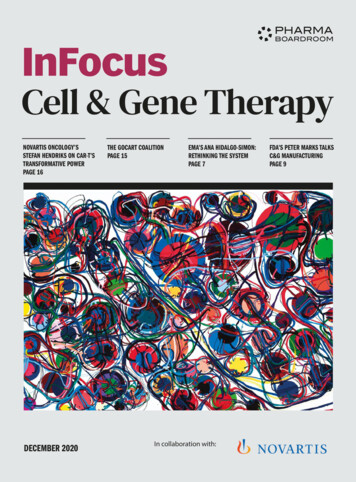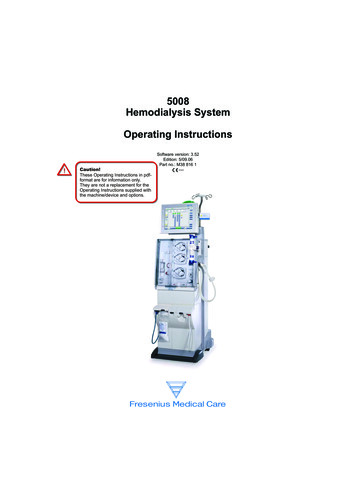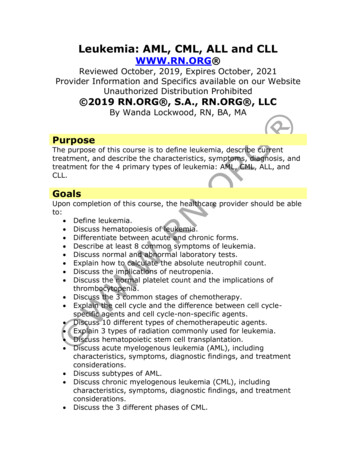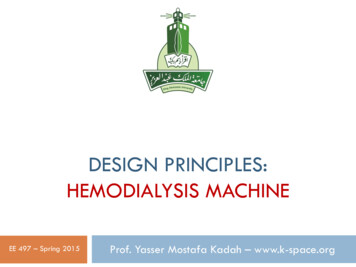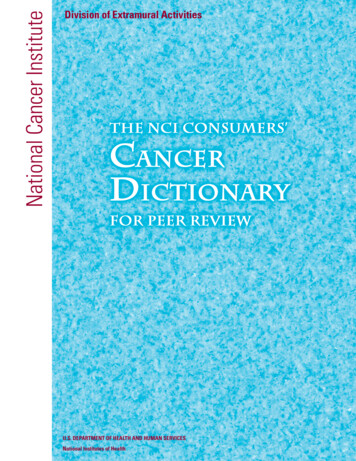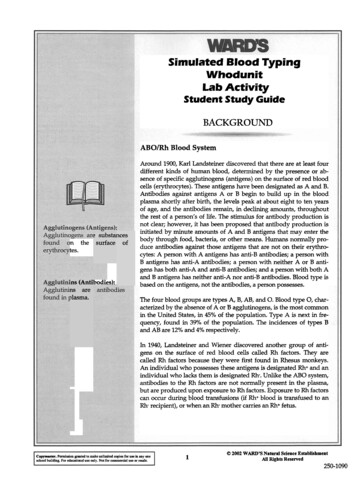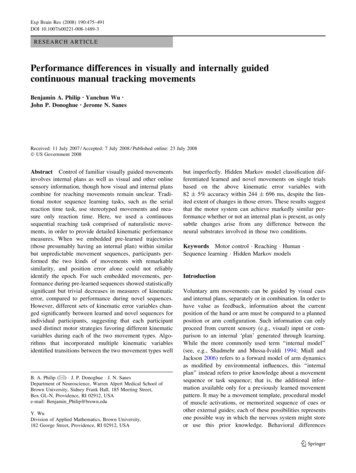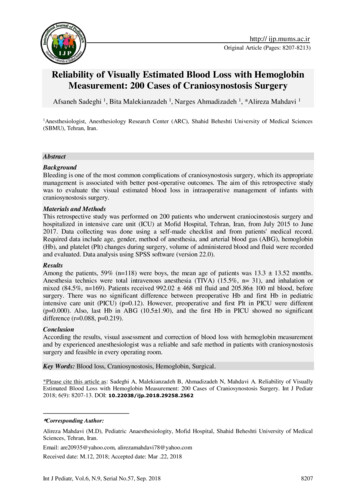
Transcription
http:// ijp.mums.ac.irOriginal Article (Pages: 8207-8213)Reliability of Visually Estimated Blood Loss with HemoglobinMeasurement: 200 Cases of Craniosynostosis SurgeryAfsaneh Sadeghi 1 , Bita Malekianzadeh 1, Narges Ahmadizadeh 1, *Alireza Mahdavi 111Anesthesiologist, Anesthesiology Research Center (ARC), Shahid Beheshti University of Medical Sciences(SBMU), Tehran, Iran.AbstractBackgroundBleeding is one of the most common complications of craniosynostosis surgery, which its appropriatemanagement is associated with better post-operative outcomes. The aim of this retrospective studywas to evaluate the visual estimated blood loss in intraoperative management of infants withcraniosynostosis surgery.Materials and MethodsThis retrospective study was performed on 200 patients who underwent craniocinostosis surgery andhospitalized in intensive care unit (ICU) at Mofid Hospital, Tehran, Iran, from July 2015 to June2017. Data collecting was done using a self-made checklist and from patients' medical record.Required data include age, gender, method of anesthesia, and arterial blood gas (ABG), hemoglobin(Hb), and platelet (Plt) changes during surgery, volume of administered blood and fluid were recordedand evaluated. Data analysis using SPSS software (version 22.0).ResultsAmong the patients, 59% (n 118) were boys, the mean age of patients was 13.3 13.52 months.Anesthesia technics were total intravenous anesthesia (TIVA) (15.5%, n 31), and inhalation ormixed (84.5%, n 169). Patients received 992.02 468 ml fluid and 205.86 100 ml blood, beforesurgery. There was no significant difference between preoperative Hb and first Hb in pediatricintensive care unit (PICU) (p 0.12). However, preoperative and first Plt in PICU were different(p 0.000). Also, last Hb in ABG (10.5 1.90), and the first Hb in PICU showed no significantdifference (r 0.088, p 0.219).ConclusionAccording the results, visual assessment and correction of blood loss with hemoglobin measurementand by experienced anesthesiologist was a reliable and safe method in patients with craniosynostosissurgery and feasible in every operating room.Key Words: Blood loss, Craniosynostosis, Hemoglobin, Surgical.*Please cite this article as: Sadeghi A, Malekianzadeh B, Ahmadizadeh N, Mahdavi A. Reliability of VisuallyEstimated Blood Loss with Hemoglobin Measurement: 200 Cases of Craniosynostosis Surgery. Int J Pediatr2018; 6(9): 8207-13. DOI: 10.22038/ijp.2018.29258.2562*Corresponding Author:Alireza Mahdavi (M.D), Pediatric Anaesthesiologity, Mofid Hospital, Shahid Beheshti University of MedicalSciences, Tehran, Iran.Email: are20935@yahoo.com, alirezamahdavi78@yahoo.comReceived date: M.12, 2018; Accepted date: Mar .22, 2018Int J Pediatr, Vol.6, N.9, Serial No.57, Sep. 20188207
Visually Estimated Blood Los with Hemoglobin Measurement1- INTRODUCTIONCraniosynostosis is a condition inwhich one or more cranial vault suturesprematurely fused by ossification thatleads to abnormal shape of the skull. Itsprevalence is approximately 1 per 2,000live births. In addition to aesthetic issues,this disorder can lead to increasedintracranial pressure (ICP), optic orauditory nerves impairments or cognitiveimpairment. Craniosynostosis in 85% ofcases are isolated and 15% syndromic andinvolve various systems of the body (1, 2).The treatment is surgical repair during thefirst few months of life. Althoughcraniosynostosis repair appears to berelatively safe in the absence of underlyingdiseases, the perioperative period can bevery complicated (3, 4).One of the major complications associatedwith surgery is high excessive bleeding(5). Perioperative bleeding can occurslowly or acutely that massive transfusionis required. Bleeding mainly is high riskfor infants with lower age and weight, andin long duration surgeries like syndromictype. A number of Studies showed that theaverage volume of transfusion is 50 ml/kgbut may reach to more than 100 ml/kg (6,7). Keeping in mind, the main challenge insurgical and anesthetic management ofcraniosynostosis patients is to control andcorrect the hemorrhage and care should befocused on maintaining hemodynamicstability and prevention of coagulationdisorder. Many researches are carried onmanagement of bleeding and s surgery (8, 9).These approaches include less invasivesurgical techniques such as endoscopicsurgery, or modifying open surgicaltechniques(10), prescribing iron orerythropoietin before surgery, on techniques such as cell salvageand preoperative autologous blooddonation. These techniques are usuallyInt J Pediatr, Vol.6, N.9, Serial No.57, Sep. 2018easy to use in older children and adults,but in infants need special equipment andskilled personnel (7, 10-27). Furthermore,overestimation or underestimation ofbleeding and transfusion has minor andmajor complications including risks relatedtomassivetransfusion,increasedmyocardial workload a, pulmonary edema,anemia, cerebral hypoxia and longerduration of stay in intensive care unit(ICU) (28, 29). The accurate estimation ofbleeding and appropriate compensation incraniosynostosis surgery remains a majorchallenge for anesthesiologist (30-33).Using visual estimation of blood loss suchas the volume of suctioned blood, drapes,swabs, blood shed on floor, soakedsurgical gowns and bloody gauze arecontroversial. Other various methods, suchas measuring hemoglobin (Hb) andhematocrit (Hct), and gravimetric centralvenous pressure (CVP), and electricalconductivity measurements are used. Theunavailability of equipment and personnelfor performing laboratory tests, the longduration of surgery and financial issues arethe limitation of these methods (28, 34,35). This study aimed to determinereliability of visually estimated blood losswith hemoglobin measurement which is asimple and feasible method in everyoperating room.2- MATERIALS AND METHODSIn this retrospective, cross sectionalstudy, 200 patients who underwentprimary reconstruction of craniosynostosisat Mofid Hospital, Tehran-Iran, from July2015 to June 2017 were included to thestudy. The study was approved by hospitalethics committee. Sample size wasestimated by sample size calculatorsoftware with 95% confidence interval andp 0.05 considered analytically significant.Inclusion criteria were non syndromiccraniosynostosis primary repair, age lessthan 10 years. Exclusion criteria werepatients with life threatening underlying8208
Sadeghi et al.disease such as heart and pulmonarydiseases, anemia, coagulation disorders,hypothyroidism, metabolic disorders (36)and meningitis. The same team ofsurgeons and anesthesiologists wereresponsible for all the cases in our study.Perioperative period was from start ofanesthesia until entrance to recovery.Postoperative period was from enteringrecovery room until discharge frompediatric intensive care unit (PICU).Anesthesia technics were total intravenousanesthesia (TIVA), and inhalation ormixed. In TIVA, induction was performedwith thiopental 5mg/kg, fentanyl 2 µg/kgand atracurium 0.5 mg/kg in both groupsand patients were intubated with spiralUncuffed Endotracheal Tube (ETT).In addition to standard monitoring (Bloodpressure(BP),Pulse rate (PR),Electrocardiography (ECG), end tidalcarbon dioxide (ETCO2), invasivemonitoring including arterial line andcentral venous catheter was established.All of patients were in 15 degree head upposition. Maintenance of anesthesia wasprovided by Isoflurane (1 MAC) in groupA and Propofol 150 ug/kg/min andremifentanil 0.1ug/kg/min in group B. Themean blood pressure (MAP), and heart rate(HR) were recorded every 5 minutes. Ininhalation anesthesia method, 15 minutesbeforestartingcraniotomy,hyperventilation with the aim of keepingpartial pressure of end tidal carbon dioxide(PETCO2) around 25-30 and Paco2 30-35mmHg was established.Also, normocapnia (PETCO2 35 mmHg)was maintained. ABG samples were usedto measure Paco2. During surgery, thesurgeon evaluated intra cranial pressure(ICP) (37). Data collecting was done usinga self-made checklist and from patients’medical record after allowing the memberstaffs who were responsible formaintaining the patients’ records. Datainclude duration of anesthesia, volume oftransfusion blood and fluid intake,Int J Pediatr, Vol.6, N.9, Serial No.57, Sep. 2018receiving calcium and fresh frozen plasma(FFP). Total amount of bleeding wasestimated based on ml of blood in suctiontank and gauzes and surgical fields bycontinue evaluation of anesthesiologistduring operation (31). Using eachindividualpatient’spreoperativehemoglobin (Hb), Hb lost was convertedto volume of blood loss with the formulaVolume in mL measured Hb loss in g (100 mL/dL)/(Preoperative Hb in g/dL)(5).Allpatients’demographiccharacteristics such as age, weight, gender,duration of anesthesia and lab results forprimary outcomes including preoperativehemoglobin and platelets, last Hb inarterial blood gas (ABG), first Hb andplatelets (Plt) in PICU were recorded. LastHg of ABG had been usually checked andnoted in anesthesia chart preoperatively tohave a document for legal issues.Secondary outcomes including fever inPICU, volume of blood transfusion andfluid intake and length of PICU stay werealso recorded.Statistical analysis was conducted by usingSPSS 22.0 software (Chicago, IL, USA).The parametric variables were presented asmean standard deviation [SD] andanalyzed by student t-test and asappropriate. For non- parametric variablesChi-square or Mann-Whitney U-test wereused, also p-value less than 0.05 wasconsidered as statistically significant.3- RESULTSA total of 210 cases were investigated,of which 10 were excluded due toinadequate information in their medicalrecord. Finally, 200 patients were enrolledin the study that among them 59% (n 118)were boys and 41% (n 82) were girls. TheMean age was 13.3 13.52 months (2.5 to108 months). The mean weight of patientswas 9.30 3.17 Kilograms (5 to 30 kg).Anesthesia techniques were TIVA 15.5%(n 31) and inhalation or mixed 84.5% (n 169). The mean duration of anesthesia was8209
Visually Estimated Blood Los with Hemoglobin Measurement6.9 0.87 hours and the patients received992.02 468 mL fluid and 205.86 100mL blood during surgery. Also, thevolume of fluid intake to weight ratio was110.01 45.88 ml/kg and the volume oftransfused blood to weight ratio was 23.04 12.33 ml/kg. The mean PICU length ofstay was 32.2 14.03 hours (8 to 96 h).None of the patients received FFP, while80% (n 159) of them received Calciumintravenously. Bleeding in drain bagoccurred in more than 50% (n 101) of thepatients and 11% (n 22) had fever(temperature 38 degrees centigrade) inPICU. There was no death during or aftersurgery. Table.1 shows preoperative Hgand platelet and first measurement of Hgand platelet of patients in PICU. There wasnosignificantdifferencebetweenpreoperative Hb and first Hb in PICU(p 0.12). Preoperative and first Plt countin PICU were significantly different(p 0.000). Also, Last Hb in ABG(10.5 1.90) and the first Hb in PICUshowed no difference. (t 0.088, p 0.219).Table-1: The comparison of Preoperative Hb and Plt with first Hg and Plt in PICU.VariablesHemoglobinPlateletBefore surgeryMean SD11.35 1.04In PICUMean SD11.13 1.89t-testP-value1.560.12371400 287330212050 74760-8.300.000PICU: Pediatric intensive care; SD: Standard deviation.4- DISCUSSIONThis study showed that closeobservation of hemodynamic changes andcontinues visual monitoring of blood lossby anesthesiologist is a reliable and safemethod to estimate blood loss andresulting accurate corrections. Blood losswas compensated acceptably and first Hbin PICU was close to preoperative values.Although in previous studies, variousmethods such as colorimetric Hb,osmolarity and gravimetric were used toestimate blood loss during surgery, but dueto their limitations they did not succeedperfectly. In agree with our study, someresearchers resulted that close monitoringof hemodynamics and central venouspressure (CVP), and Hb measurementswere preferred approach (33, 35). Guinnet al., compared anesthesiologist estimatesof intraoperative blood loss with measuredHb loss to determine the accuracy ofintraoperative blood loss estimation in 60patients undergoing posterior spinesurgery. Level of Hb was converted intovolume of blood lost and compared withInt J Pediatr, Vol.6, N.9, Serial No.57, Sep. 2018estimates of blood loss. They concludedthat estimated blood loss exceededmeasured blood loss by 40% on average.The finding of Guinn study does notsupport our results that may be due to thedifferences between anesthesiology teamin visually estimated blood loss todetermineHbconcentrationofsanguineous solutions in suction canistersand surgical sponges (5). Hass et al. (2014)investigated improvements in patient bloodmanagement for pediatric tometry (ROTEM) (38). Intheir study, the amount of unnecessarytransfusion was significantly reduced. Insome of the studies, simple objectivetechniques have been successful indetermining the endpoint for transfusion orHb measurement (5, 39). However, inJareonrattanadaechakul study (2017), chartfor visual estimation was applied whichwas more reliable than visual estimationmethod alone (40). In contrast to ourresults, in studies conducted on midwiferyand cesarean section, orthopedics and8210
Sadeghi et al.urology surgeries, visual estimation ofblood loss were not a precision methodand delayed diagnosis or underestimate ofblood loss have been reported (41, 42).Furthermore, in two studies, using bloodgas measurements in the estimation ofblood loss was more reliable than visualapproach (45, 46). However, Seruya et al.(2011) who compared estimated blood loss(EBL) and calculated blood loss (CBL)based on Hb in craniotomy surgerypatients, both methods was associated withunderestimated and overestimation tocompensate of blood loss (43). There wasa significant difference between the meanplatelet count before and after the surgery,which may be due to uncompensated Pltduringsurgeryanddilutionalthrombocytopenia. In the present study,the mean length of stay in the PICU was32.2 hours, which is less than Shastin et al.(2017) study that was 3.5 days in patientswith craniosynostosis surgery (44).5- CONCLUSIONIt may be due to keeping hemodynamicstability during surgery and not requiredintensive hemodynamic challenges inPICU which resulted faster discharge.Also, none of the patients in our studyreceived FFP, and died in PICU. Since themost important factor of mortality in thissurgery is massive bleeding andconsequent coagulopathy, our acceptablemanagement of bleeding caused thesefindings. In addition, the mean average oftransfused blood was lower than 1.5 bloodvolume of patients (23.04 12.33 ml/kg)so, FFP was not administered.4.Nguyen C, Hernandez-Boussard T,Khosla RK, Curtin CM. A national study oncraniosynostosis surgical repair. The CleftPalate-Craniofacial Journal. 2013;50(5):55560.4-1. Limitations of the studyOne of the limitations of this study waslack of long post-operative outcomes suchas need for transfusion in PICU period.Also, we did not record type of anomalieswhich are important factors affecting timeof surgery and amount of bleeding. Werecommend another prospective studyaimed to visual assessment of bleedingalong with serial screening component ofHct in ABGs.Int J Pediatr, Vol.6, N.9, Serial No.57, Sep. 2018According to the results, visualassessment of bleeding with Hbmeasurement can be a reliable method toassess blood loss during craniosynostosissurgery. Further studies are recommendedto confirm our findings.6- CONFLICT OF INTEREST: None.7- REFERENCES1.Kim HJ, Roh HG, Lee IW.Craniosynostosis: Updates in radiologicdiagnosis. Journal of Korean NeurosurgicalSociety. ir.pediatrics. 2014;3(3):247.EndoscopicTranslational3.Di Rocco C, Tamburrini G, Pietrini D,editors. Blood sparing in craniosynostosissurgery. Seminars in pediatric neurology;2004: Elsevier.5.Guinn NR, Broomer BW, White W,Richardson W, Hill SE. Comparison ofvisually estimated blood loss with directhemoglobin measurement in multilevel spinesurgery. Transfusion. 2013;53(11):2790-4.6.Pearson A, Matava C. Anaestheticmanagement for craniosynostosis repair inchildren. Bja Education. 2016;16(12):410-6.7.Thomas K, Hughes C, Johnson D, DasS. Anesthesia for surgery related tocraniosynostosis: a review. Part 1. PediatricAnesthesia. 2012;22(11):1033-41.8.Kucuk A, Tumturk A, Gergin IS, OralS, Gorkem SB, Kurtsoy A, et al. Themanagement of blood loss in non-syndromiccraniosynostosis patients undergoing 41.9.White N, Marcus R, Dover S, SolankiG, Nishikawa H, Millar C, et al. Predictors ofblood loss in fronto-orbital advancement and8211
Visually Estimated Blood Los with Hemoglobin Measurementremodeling. Journal of Craniofacial Surgery.2009;20(2):378-81.10.Goobie SM, Haas T. Bleedingmanagement for pediatric craniotomies andcraniofacial surgery. Pediatric Anesthesia.2014;24(7):678-89.11.Pietrini D, Goobie S. ostosis surgery. Pediatric Anesthesia.2013;23(3):278-84.12.Anantheswar Y, Venkataramana N.Pediatriccraniofacialsurgeryforcraniosynostosis: Our experience and currentconcepts: Part-1. Journal of pediatricneurosciences. 2009;4(2):86.13.Bonhomme V, Damas F, Born J, HansP, editors. Perioperative management of s.Annalesfrancaisesd'anesthesie et de reanimation; 2002.14.Mekitarian Filho E, De Carvalho WB,Cavalheiro S, Horigoshi NK, Freddi NA.Perioperativefactorsassociatedwithprolonged intensive care unit and hospitallength of stay after pediatric neurosurgery.Pediatric neurosurgery. 2011;47(6):423-9.15.Song G, Yang P, Hu J, Zhu S, Li Y,Wang Q. The effect of tranexamic acid onblood loss in orthognathic surgery: a metaanalysis of randomized controlled trials. Oralsurgery, oral medicine, oral pathology and oralradiology. 2013;115(5):595-600.16.Song G, Yang P, Zhu S, Luo E, FengG, Hu J, et al. Tranexamic acid reducing issurgery.JournalofCraniofacial Surgery. 2013;24(1):299-303.17.van Uitert A, Megens JH, BreugemCC, Stubenitsky BM, Han KS, de Graaff JC.Factors influencing blood loss and allogeneicblood transfusion practice in 1(12):1192-7.18.Kearney RA, Rosales JK, Howes WJ.Craniosynostosis: an assessment of blood lossand transfusion practices. Canadian journal ofanaesthesia. 1989;36(4):473-7.19.Cárdenas VHG, Martínez MVV,Rueda MER, Guevara NS, Prada JR, BaqueroInt J Pediatr, Vol.6, N.9, Serial No.57, Sep. 2018P. Anestesia para craneosinostosis. 204.20.Hsu G, Taylor J, Fiadjoe J, Vincent A,Pruitt E, Bartlett S, et al. Aminocaproic acidadministration is associated with reducedperioperative blood loss and transfusion caScandinavica.2016;60(2):158-65.21.Stricker PA, Fiadjoe JE. Anesthesiafor craniofacial surgery in infancy.Anesthesiology clinics. 2014;32(1):215-35.22.Velardi F, Di Chirico A, Di Rocco C,Fundaro C, Genovese O, Rendeli C, et al. “NoAllogeneic Blood Transfusion” protocol forthe surgical correction of craniosynostoses II.Clinical application. Child's Nervous System.1998;14(12):732-9.23.Krajewski K, Ashley RK, Pung N,Wald S, Lazareff J, Kawamoto HK, et al.Successfulbloodconservation duringcraniosynostotic correction with dual therapyusing procrit and cell saver. Journal ofCraniofacial Surgery. 2008;19(1):101-5.24.Faberowski L, Black S, Mickle J.Blood loss and transfusion practice in theperioperative management of hesiology. 1999;11(3):167-72.25.Hansen JK, Lydick AM, Wyatt MM,Andrews BT. Reducing PostoperativeBleeding After Craniosynostosis RepairUtilizing a Low-Dose Transexamic AcidInfusion Protocol. Journal of CraniofacialSurgery. 2017;28(5):1255-9.26.Koh JL, Gries H. Perioperativemanagement of pediatric patients withcraniosynostosis. Anesthesiology clinics.2007;25(3):465-81.27.Ursitti F, Fadda T, Papetti L, PagnoniM, Nicita F, Iannetti G, et al. Evaluation ediatrica.2011;100(9):1185-94.28.Bower W, Jin L, Underwood M. Perioperative blood transfusion increases length ofhospital stay and number of postoperativecomplications in non-cardiac surgical patients.Hong Kong Med J. 2010;16(2):116-20.8212
Sadeghi et al.29.Williams GD, Ellenbogen RG, GrussJS. Abnormal coagulation during pediatriccraniofacial surgery. Pediatric neurosurgery.2001;35(1):5-12.30.Vlayen A, Verelst S, Bekkering GE,Schrooten W, Hellings J, Claes N. Incidenceand preventability of adverse events requiringintensive care admission: a systematic review.Journal of evaluation in clinical oroozanfar MM, Razavi SS, Mohajerani R,Eghbali A, et al. Effect of PerioperativeManagement on Outcome of Patients afterCraniosynostosis Surgery. World journal ofplastic surgery. 2017;6(1):48.32.Seruya M, Oh AK, Rogers GF, HanKD, Boyajian MJ, Myseros JS, et al. :implicationsforbloodtransfusion practice and hospital length ofstay. Journal of Craniofacial Surgery.2012;23(5):1314-7.33.Ali A, Basaran B, Yornuk M, Altun D,Aydoseli A, Sencer A, et al. Factorsinfluencing blood loss and nostosis surgery: a retrospectivestudy. Pediatric neurosurgery. 2013;49(6):33946.34.Abbasi S, Enam S. Comparison ofvisual estimation of blood loss with serial Hband Hct estimation in supratentorialcraniotomy. Blood Loss. 2011.35.Hare GM, Tsui AK, McLaren AT,Ragoonanan TE, Yu J, Mazer CD. Anemia andcerebral outcomes: many questions, 56-70.36.Yazdiha MS, Ghorbani R, Behshad J,Hoseini SM, Razavi M, Emadi A. Relationshipbetween idiopathic hypercalciuria and urinarytract infection in children of 1-14 years of age.koomesh Journal. 2016;18(1): 153-8.37.Mahdavi A, Malekianzadeh B,Sadeghi AS. The Effect of InhalationInt J Pediatr, Vol.6, N.9, Serial No.57, Sep. 2018Anesthesia with Hyperventilation and totalIntravenous Anesthesia on IntracranialPressure Control in Pediatrics withCraniosynostosis Surgery: A RandomizedClinical Trial. International Journal ofPediatrics. 2018.38.Haas T, Goobie S, Spielmann N,Weiss M, Schmugge M. Improvements inpatient blood management for pediatriccraniosynostosissurgeryusingaROTEM ‐assisted strategy–feasibility andcosts. Pediatric Anesthesia. 2014;24(7):77480.39.Ashraf Aly H, Ramadani HM.Assessment of blood loss during cesareansection under general anesthesia and epiduralanalgesia using different methods. ctiveness of guide charts for visualestimation of intraoperative blood loss foranesthesia providers at Maharaj NakornChiang Mai Hospital. Thailand Journal ofAnesthesiology. 2017;41(1):27-39.41.Algadiem EA, Aleisa AA, AlsubaieHI, Buhlaiqah NR, Algadeeb JB, Alsneini HA.Blood loss estimation using gauze visualanalogue. Trauma monthly. 2016;21(2).42.Zuckerwise L, Raab C, Buhimschi C,Pettker C, Lipkind H. 541: Estimating bloodloss: can an easily accessible visual aidsignificantly improve visual estimation?AmericanJournalofObstetrics&Gynecology. 2013;208(1):S232-S3.43.Seruya M, Oh AK, Boyajian MJ,Myseros JS, Yaun AL, Keating RF.Unreliability of intraoperative estimated bloodloss in extended sagittal 11;8(5):443-9.44.Shastin D, Peacock S, Guruswamy V,Kapetanstrataki M, Bonthron DT, Bellew M,et al. A proposal for a new classification ofcomplications in craniosynostosis ):675-83.8213
Uncuffed Endotracheal Tube (ETT). In addition to standard monitoring (Blood pressure (BP), Pulse rate (PR), Electrocardiography (ECG), end tidal carbon dioxide (ETCO2), invasive monitoring including arterial line and central venous catheter was established. All of patients were in 15 degree head up position.
